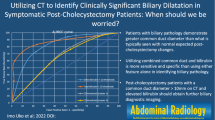Abstract
The purpose of this study was to determine the prevalence and characteristics of the cisterna chyli (CC) in a large 3,000-patient cohort and to identify potential predisposing factors for the development of a CC. Three thousand consecutive contrast-enhanced CT examinations (1,261 women, 1,739 men, mean age 61.0 years) of the chest and/or abdomen were included in this retrospective study. Imaging characteristics of the CC (size, attenuation, location) were documented as well as clinical information (malignant disease, pattern of metastasis). A CC was found in 16.1% of the patients with an average volume of 302 µl. The mean attenuation was 4.8 Hounsfield units (HU). Twenty percent of the CC showed CT densities of 15 HU and higher. Patients with malignancies showed a significantly (p < 0.001) higher prevalence of CC (340/1,757, 19.4%) than patients with benign conditions (144/1,243, 11.6%). Especially the finding of a large CC (>1,000 µl) represents an elevated relative risk for malignancy of 1.7 (p = 0.0017). We found a significant association between malignant disease and the presence and size of a cisterna chyli. Identifying the continuity between the CC and the thoracic duct is a safer method to distinguish a CC from retrocrural lymph nodes than near-water CT attenuation alone.



Similar content being viewed by others
References
Platis IE, Nwogu CE (2006) Chylothorax. Thorac Surg Clin 16:209–214
Smith TR, Grigoropoulos J (2002) The cisterna chyli: incidence and characteristics on CT. Clin Imaging 26:18–22
Pinto PS, Sirlin CB, Andrade-Barreto OA et al (2004) Cisterna chyli at routine abdominal MR imaging: a normal anatomic structure in the retrocrural space. Radiographics 24:809–817
Loukas M, Wartmann CT, Louis RG Jr. et al (2007) Cisterna chyli: a detailed anatomic investigation. Clin Anat 20:683–688
Rosenberger A, Abrams HL (1971) Radiology of the thoracic duct. Am J Roentgenol Radium Ther Nucl Med 111:807–820
Erden A, Fitoz S, Yagmurlu B et al (2005) Abdominal confluence of lymph trunks: detectability and morphology on heavily T2-weighted images. AJR Am J Roentgenol 184:35–40
Propst-Proctor SL, Rinsky LA, Bleck EE (1983) The cisterna chyli in orthopaedic surgery. Spine 8:787–792
Hosmer DW, Lemeshow S (2001) Applied logistic regression (2nd edn). John Wiley & Sons Inc, New York
Gollub MJ, Castellino RA (1996) The cisterna chyli: a potential mimic of retrocrural lymphadenopathy on CT scans. Radiology 199:477–480
Author information
Authors and Affiliations
Corresponding author
Rights and permissions
About this article
Cite this article
Feuerlein, S., Kreuzer, G., Schmidt, S.A. et al. The cisterna chyli: prevalence, characteristics and predisposing factors. Eur Radiol 19, 73–78 (2009). https://doi.org/10.1007/s00330-008-1116-5
Received:
Revised:
Accepted:
Published:
Issue Date:
DOI: https://doi.org/10.1007/s00330-008-1116-5




